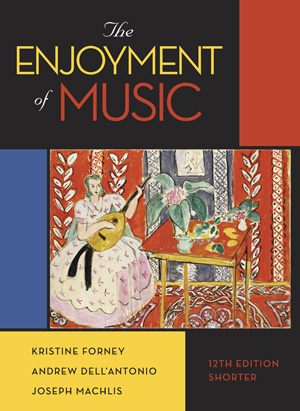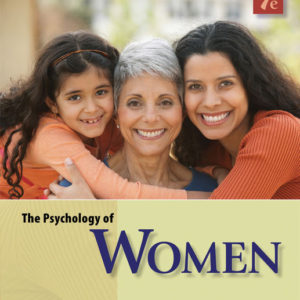- You cannot add another "Lehne's Pharmacotherapeutics for Advanced Practice Providers 1st Edition Test Bank" to your cart. View cart
Test Bank for The Enjoyment of Music 12th Edition Kristine Forney, Andrew Dell’Antonio, Joseph Machlis,
$35
Description
Test Bank for The Enjoyment of Music 12th Edition Kristine Forney, Andrew Dell’Antonio, Joseph Machlis
CONTENTS
Part 1 Materials of Music
Prelude 1 | Listening to Music Today 1
Chapter 1 | Melody: Musical Line 4
Chapter 2 | Rhythm and Meter: Musical Time 8
Chapter 3 | Harmony: Musical Depth 13
Chapter 4 | The Or ga ni zation of Musical Sounds 17
Chapter 5 | Musical Texture 23
Chapter 6 | Musical Form 27
Chapter 7 | Musical Expression: Tempo and
Dynamics 31
Chapter 8 | Music and Words 34
Chapter 9 | Voices and Instrument Families 37
Chapter 10 | Western Musical Instruments 40
Chapter 11 | Musical Ensembles 46
Chapter 12 | Style and Function of Music
in Society 50
Part 2 The Middle Ages
and Re nais sance
Prelude 2 | Music as Commodity and Social
Activity 53
Chapter 13 | Voice and Worship: Tradition and
Individuality in Medieval Chant 57
Chapter 14 | Layering Lines: Polyphony at
Notre Dame 61
Chapter 15 | Symbols and Puzzles: Machaut and
the Medieval Mind 64
Chapter 16 | Singing in Friendship: The
Renaissance Madrigal 67
Chapter 17 | Remember Me: Personalizing the
Motet in the Re nais sance 70
Chapter 18 | Glory Be: Music for the Re nais sance
Mass 73
Chapter 19 | Instrumental Movements: Medieval
and Re nais sance Dance Music 77
Part 3 The Baroque Era
Prelude 3 | Music as Exploration and Drama 80
Chapter 20 | Voicing the Virgin: Cozzolani and
Italian Baroque Sacred Music 85
Chapter 21 | Performing Grief: Purcell and
Early Opera 88
Chapter 22 | Musical Sermons: Bach and the
Lutheran Cantata 92
Chapter 23 | Textures of Worship: Handel and the
En glish Oratorio 96
Chapter 24 | In dependent Study: Billings and the
North American Sacred Tradition 100
Chapter 25 | Grace and Grandeur: The Baroque
Dance Suite 104
Chapter 26 | Sounding Spring: Vivaldi and the
Baroque Concerto 108
Chapter 27 | Pro cess as Meaning: Bach and
the Fugue 112
Part 4 Eighteenth- Century Classicism
Prelude 4 | Music as Order and Logic 116
Chapter 28 | Musical Conversations: Haydn
and Classical Chamber Music 121
Chapter 29 | The Ultimate Instrument: Haydn
and the Symphony 126
Chapter 30 | Expanding the Conversation:
Mozart, Chamber Music, and
Larger Forms 130
Chapter 31 | Conversation with a Leader: The
Classical Concerto 135
Chapter 32 | Personalizing the Conversation:
Beethoven and the Classical Sonata 138
Chapter 33 | Disrupting the Conversation: Beethoven
and the Symphony in Transition 142
Chapter 34 | Making It Real: Mozart and
Classical Opera 145
Chapter 35 | Mourning a Hero: Mozart and
the Requiem 148
Part 5 The Nineteenth Century
Prelude 5 | Music as Passion and Individualism 151
Chapter 36 | Musical Reading: Schubert, Schumann,
and the Early Romantic Lied 157
Chapter 37 | Marketing Music: Foster and Early
“Pop u lar” Song 164
Chapter 38 | Dancing at the Keyboard: Chopin and
Romantic Piano Music 167
Chapter 39 | Musical Diaries: Hensel and
Programmatic Piano Music 172
Chapter 40 | Piano Triumphant: Gottschalk and
Romantic Virtuosity 175
Chapter 41 | Personal Soundtracks: Berlioz and
the Program Symphony 178
Chapter 42 | Sounding a Nation: Grieg and
Orchestral Nationalism 183
Chapter 43 | Absolutely Classic: Brahms and the
Nineteenth- Century Symphony 188
Chapter 44 | Multimedia Hits: Verdi and Italian
Romantic Opera 193
Chapter 45 | Total Art: Wagner and German
Romantic Opera 198
Chapter 46 | Poetry in Motion: Tchaikovsky
and the Ballet 203
Chapter 47 | Exotic Allure: Puccini and the Italian
Verismo Tradition 207
Chapter 48 | Accepting Death: Fauré and
the Requiem 211
Chapter 49 | Mythical Impressions: Program Music
at the End of the Nineteenth Century 214
Chapter 50 | Jubilees and Jubilation: The African
American Spiritual Tradition 220
Chapter 51 | A Good Beat: American Vernacular
Music at the Close of an Era 224
Part 6 Twentieth- Century Modernism
Prelude 6 | Making Music Modern 228
Chapter 52 | Anything Goes: Schoenberg and
Musical Expressionism 234
Chapter 53 | Calculated Shock: Stravinsky
and Modernist Multimedia 239
Chapter 54 | Still Sacred: Religious Music in
the Twentieth Century 243
Chapter 55 | War Is Hell: Berg and Expressionist
Opera 246
Chapter 56 | American Intersections: Jazz and
Blues Traditions 250
Chapter 57 | Modern Ame rica: Still and Musical
Modernism in the United States 256
Chapter 58 | Folk Opera? Gershwin and Jazz
as “Art” 259
Chapter 59 | Sounds American: Ives, Copland,
and Musical Nationalism 263
Chapter 60 | Also American: Revueltas and Mexican
Musical Modernism 268
Chapter 61 | Classic Rethinking: Bartók and the
“Neo- Classical” Turn 272
Part 7 Postmodernism:
The Twentieth Century and Beyond
Prelude 7 | Beyond Modernism? 277
Chapter 62 | New Sound Palettes: Mid- Twentieth-
Century American Experimentalists 282
Chapter 63 | Staged Sentiment: Bernstein and
American Musical Theater 287
Chapter 64 | Less Is More: Reich and Minimalist
Music 291
Chapter 65 | Returning with Interest: Dylan,
Corigliano, and Postmodern
Reworkings 295
Chapter 66 | Neo- Romantic Evocations: Higdon and
Program Music into the Twenty-
First Century 298
Chapter 67 | Underscoring Meaning: Music
for Film 301
Chapter 68 | Icons in Sound: Tavener and
Postmodern Orthodoxy 306
Chapter 69 | Reality Shows: Adams and
Contemporary Opera
Prelude 1: Listening to Music Today
MULTIPLE CHOICE
1. Which of the following are NOT good sources of concert information?
a. city and college newspapers c. college music or fine arts departments
b. websites of nearby venues d. recently issued CDs
ANS: D DIF: Easy REF: 4 TOP: Concerts
MSC: Applied
2. What is the best way to prepare in advance to attend an opera?
a. practice speaking the language in which it will be performed
b. read an overview of the plot
c. buy a new outfit to wear
d. read biographies of the singers
ANS: B DIF: Easy REF: 5 TOP: Concerts
MSC: Applied
3. A good source to find out more about works to be performed at a concert is:
a. your music textbook. c. Internet.
b. online materials with textbook. d. all of the above
ANS: D DIF: Medium REF: 5 TOP: Concerts
MSC: Factual
4. If you arrive at a concert after the performance has begun, you should:
a. enter and crawl over people to find your seat.
b. enter and stand in the aisle until there is a break.
c. wait until there is a break in the music, then enter and quickly find your seat.
d. give up and go home.
ANS: C DIF: Medium REF: 6 TOP: Concerts
MSC: Applied
5. During a concert, it is appropriate to leave your seat:
a. whenever you are bored. c. only at the end of the program.
b. during breaks in the works. d. only during intermission and at the end.
ANS: D DIF: Medium REF: 6 TOP: Concerts
MSC: Applied
6. In a symphony concert, after the orchestra is seated, the first individual to walk on stage is:
a. the conductor. c. the music director.
b. the soloist. d. the concertmaster.
ANS: D DIF: Medium REF: 7 TOP: Concerts
MSC: Factual
2 | Prelude 1
7. At a symphony concert, you should applaud:
a. after well-performed solos. c. only at the ends of complete works.
b. at breaks in the works. d. only at the close of the concert.
ANS: C DIF: Medium REF: 7 TOP: Concerts
MSC: Applied
8. Which of the following is NOT an established concert tradition?
a. performers wearing dark clothing
b. question-and-answer sessions with the audience during the concert
c. pianists and singers performing from memory
d. orchestras standing when the conductor enters
ANS: B DIF: Hard REF: 7 TOP: Concerts
MSC: Factual
TRUE/FALSE
1. In daily life, we often listen to music as a background to another activity.
ANS: T DIF: Easy REF: 4 TOP: Concerts
MSC: Factual
2. Listening to music at home is just about the same experience as hearing it live.
ANS: F DIF: Easy REF: 4 TOP: Concerts
MSC: Applied
3. Front-row orchestra seats are the best location from which to hear a balanced performance by an
orchestra.
ANS: F DIF: Medium REF: 5 TOP: Concerts
MSC: Applied
4. In general, you should plan to arrive at a concert at least twenty minutes before it is scheduled to
begin.
ANS: T DIF: Medium REF: 6 TOP: Concerts
MSC: Factual
5. The concert program handed to you by an usher often has helpful notes about the pieces you will hear.
ANS: T DIF: Easy REF: 6 TOP: Concerts
MSC: Factual
6. Concert artists wear black attire to be dramatic and to attract notice.
ANS: F DIF: Medium REF: 7 TOP: Concerts
MSC: Conceptual
Listening to Music Today | 3
ESSAY
1. Discuss the role of music in modern life.
ANS:
Answers will vary.
DIF: Easy REF: 4 TOP: Concerts MSC: Conceptual
2. What is the best way to prepare for going to a concert?
ANS:
Answers will vary.
DIF: Easy REF: 4 TOP: Concerts MSC: Conceptual
You must be logged in to post a review.




Reviews
There are no reviews yet.